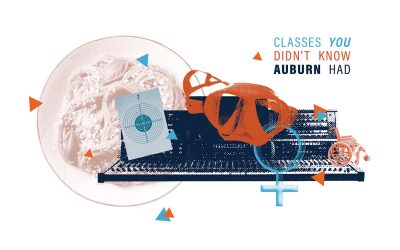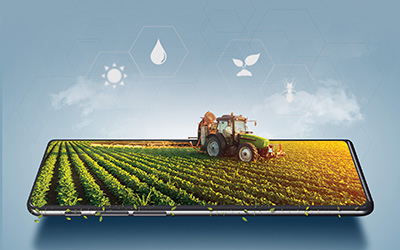Oyster expert Bill Walton builds a better bivalve mollusk
By Derek Herscovici ’14
But oysters are fickle animals, requiring specific conditions to grow, harvest and ship them across the country. Fortunately, oyster farmers can rely on the expertise of Bill Walton, associate professor and extension specialist with the School of Fisheries, Aquaculture and Aquatic Sciences.
A self-professed “oyster geek,” in 2017 Walton and his doctoral student, Vicki Pruente, at the Auburn University Shellfish Lab on Dauphin Island (and a colleague at the FDA’s Seafood Safety Lab) received a grant of $456,646 from the USDA to study methods of understanding how regional farmers can affect the safety of harvested oysters to benefit not only growers, but consumers as well.
When the oysters are harvested from the water, the small bit of seawater still inside the shell — affectionately called “oyster liquor” — often contains trace amounts of vibrios. If the oysters are left in the sun too long, however, that bacteria can multiply into a potentially lethal quantity.
“The analogy I use is a glass of cold milk: how long would you leave that on the hood of your car in August before you decide ‘maybe I shouldn’t drink that?’” says Walton. “The ballpark number of people getting sick from Vibrio vulnificus from eating raw oysters is around 50 cases [a year], so it’s a low number. The scary part is, the mortality rate is about 50 percent.”
The best way to protect customers — and farmers — is to put the oysters on ice very quickly after harvesting, especially in the warmest parts of the summer. As long as the oysters stay cold, the bacteria are kept at bay, enabling them to be served raw at far-flung restaurants while meeting public health standards.
While getting and keeping oysters cold is an industry standard, new methods of oyster farming (called ‘off-bottom’ oyster farming – see sidebar) presented new challenges. One of those challenges is that farmers need to pull the oysters out of the water for sorting and inspection, increasing the risk of vibrio numbers going up. In the past, pulling oysters out meant putting them back in the water for sometimes a month or more, potentially mucking up the product with barnacles and decreasing its value. Thanks to Walton and his team, those long waits are a thing of the past.
“I’m really happy to say, we did some research that got some wait times down to two weeks and some down to one week,” says Walton. “We proved that within one week, there was no elevated risk of vibrio for those.”
Oysters are more than a job for Walton. His wife, Beth, works for the 501(C)(3) non-profit Oyster South, which supports oyster growers, shellfish dealers, and world-class chefs like Auburn alums David Bancroft of Acre and Rob McDaniel ’02 of Springhouse.
But since Walton’s arrival in Dauphin Island, farmers switched to the “off-bottom farming” technique where the oysters are suspended in baskets or mesh bags in the middle of the water.
Aquaculture farmers buy oyster “seed” from commercial hatcheries to plant in their baskets or bags, then float or suspend them in the water until they’re ready for harvest.
Not only does off-bottom farming create a prettier, cleaner product, but it allows for more oysters to be grown in the same area.
“In 2009 we had no off-bottom oyster farms in the gulf,” said Walton. “Since 2019, we now have it approved in all 5 Gulf states and it’s happening in 4 already.” Oyster South raises funds to donate to industry members, helps educate the growing industry and connects the industry from North Carolina to Florida to Texas.
Walton takes it a step further, though. Through his raw bar catering company, The Wandering Oyster, he and his friends can introduce people to the different varieties of oysters grown in the area. As much for fun as it is for business, working the Wandering Oyster lets Walton hear consumer feedback.
“Generally, we get the ‘wow factor’ — people can’t believe that these amazing oysters are coming out of their local waters. They’re usually thrilled about it,” says Walton. “It is kind of rewarding, actually, to just pop open some oysters and just get to see people enjoying them like that.”
That’s a Class? Six Unique Classes You Didn’t Know Auburn Offers
From safely shooting a gun to cooking an excellent meal, these unique and often overlooked classes in Auburn’s curriculum may surprise you.
Artificial Intelligence and Auburn University
The future of machine learning is less about robots becoming sentient and more about helping humanity grow better crops or deliver a hotter latte. Auburn researchers are at the forefront of showing how AI will integrate into our everyday lives, one line of code at a time.
Auburn Goes to Work on Rebuilding America’s Infrastructure
Roads crack. Sewage leaks and power grids fail. America’s infrastructure is falling apart. See how Auburn is providing solutions.
That’s a Class? Six Unique Classes You Didn’t Know Auburn Offers
From safely shooting a gun to cooking an excellent meal, these unique and often overlooked classes in Auburn’s curriculum may surprise you.
Artificial Intelligence and Auburn University
The future of machine learning is less about robots becoming sentient and more about helping humanity grow better crops or deliver a hotter latte. Auburn researchers are at the forefront of showing how AI will integrate into our everyday lives, one line of code at a time.
Auburn Goes to Work on Rebuilding America’s Infrastructure
Roads crack. Sewage leaks and power grids fail. America’s infrastructure is falling apart. See how Auburn is providing solutions.


